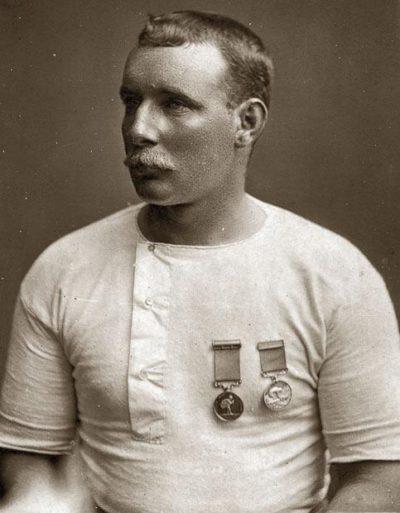Matthew Webb (Matthew Webb)

Matthew Webb was born at Dawley, Telford, in Shropshire, one of twelve children of a Coalbrookdale doctor. He acquired his ability to swim in the River Severn at Coalbrookdale. In 1860, at the age of twelve, he joined the training ship HMS Conway for two years, then entered the merchant navy and served a three-year apprenticeship with Rathbone Brothers of Liverpool. Whilst serving as second mate on the Cunard Line ship Russia, travelling from New York to Liverpool, he attempted to rescue a man overboard by diving into the sea in the mid-Atlantic. The man was never found, but Webb’s daring won him an award of £100 and the first Stanhope Medal, and made him a hero of the British press. In the summer of 1863, while at home, he rescued his 12-year-old brother Thomas from drowning in the Severn near Ironbridge. In 1873, Matthew Webb was serving as captain of the steamship Emerald when he read an account of the failed attempt by J. B. Johnson to swim the English Channel. He became inspired to try himself, and left his job to begin training, first at Lambeth Baths, then in the cold waters of the Thames, the English Channel and Hollingworth Lake. His early training was backed by Fred Beckwith who was the “Professor” at Lambeth Baths. Beckwith organised a spectacle by showing Webb swimming miles in the River Thames. Webb completed ‘nearly six miles’, but the poor public interest meant that Beckwith lost money. As a result Webb took another manager.
On 12 August 1875, Matthew Webb made his first cross-Channel swimming attempt, but strong winds and poor sea conditions forced him to abandon the swim. On 24 August, he began a second swim by diving in from the Admiralty Pier at Dover. Backed by three escort boats and smeared in porpoise oil, he set off into the ebb tide at a steady breaststroke. Despite stings from jellyfish and strong currents off Cap Gris Nez which prevented him from reaching the shore for five hours, finally, after 21 hours and 45 minutes, he landed near Calais—the first successful cross-channel swim. His zig-zag course across the Channel was over 39 miles (64 km) long. After his record swim, Captain Webb basked in national and international adulation, and followed a career as a professional swimmer. He licensed his name for merchandising such as commemorative pottery,[7] and wrote a book called The Art of Swimming. A brand of matches was named after him. He participated in exhibition swimming matches and stunts such as floating in a tank of water for 128 hours. On 27 April 1880, he married Madeline Kate Chaddock, and they had two children, Matthew and Helen. His final stunt was to be a dangerous swim through the Whirlpool Rapids on the Niagara River below Niagara Falls, a feat many observers considered suicidal. Although Webb failed in an attempt at raising interest in funding the event,[8] on 24 July 1883, he jumped into the river from a small boat located near the Niagara Falls Suspension Bridge and began his swim. Accounts of the time indicate that in all likelihood Webb successfully survived the first part of the swim, but died in the section of the river located near the entrance to the whirlpool. Matthew Webb was interred in Oakwood Cemetery, Niagara Falls, New York.
Born
- January, 19, 1848
- United Kingdom
- Dawley, England
Died
- July, 24, 1883
- Niagara River, Niagara Falls
Cause of Death
- drowning
Cemetery
- Oakwood Cemetery
- Niagra Falls, New York
- USA



